English Edition

- By CNI
- Category: English Section
- Hits: 174
CNI News
26 November 2025
The Myanmar military (Tatmadaw) may launch offensives against any area controlled by the Arakan Army (AA) in Rakhine State, said U Myo Kyaw of the United Nationalities Alliance (UNA) in an interview with CNI News.
He stated that attacks are particularly possible in areas around Kyaukphyu.
“This will likely depend on the overall situation of the whole country. In our country, when there is a ceasefire on one front, the military tends to launch offensives on another. For example, when there is a ceasefire with the Kachin, they attack the Karen. Likewise, if ceasefires occur in the eastern part of the country, large offensives may take place in the western front. In Rakhine, they can attack any area. More than fighting soldiers, they rely on military superiority—airstrikes, naval attacks, and long-range heavy artillery. These can destroy civilians and basic infrastructure such as schools, hospitals, and homes. Ceremonies, festivals, or public gatherings could also become targets. So any area could be affected. It could be in Rathedaung, in Ponnagyun, or in Minbya. Especially around Kyaukphyu. In Gwa, Taungoke—anywhere,” he said.
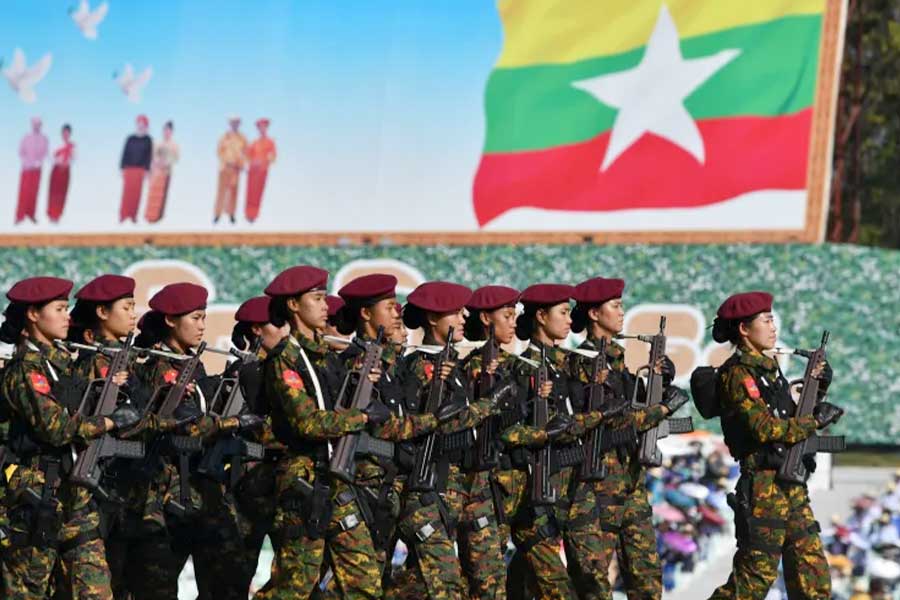
Myanmar Tatmadaw female soldiers
Currently, after halting fighting with the TNLA in northern Shan State, the Myanmar military has been conducting airstrikes on AA-controlled areas of Rakhine State, with intense clashes reported in Kyaukphyu.
Military and political analysts note that the Myanmar military may attempt a ground offensive into Rakhine State via Chin State.
Since late October, military columns from the southern part of Kalay in Sagaing Region advanced—one column moving from Webula toward Falam, and another from Tedim, passing through Thaingngin Village toward the Tedim-Falam border.
In early November, the Myanmar military captured strategic locations on the Kalay–Tedim road, including Kanedi Mountain and Thaingngin Village, an entry point into Chin State. However, Kanedi Mountain was recaptured by Chin resistance forces on November 18.

Map of Rakhine State (Photo – Myanmar Now)
Even so, U Myo Kyaw stated that it is unlikely the Myanmar military can advance into Rakhine from the Chin side.
“That’s very unlikely. It would be extremely difficult for them to retake those areas. The terrain is difficult, and from a military strategy perspective, it’s not easy for them to push back in after retreating. On top of that, Chin resistance forces in that area still hold substantial strength. So an advance from that side would be very difficult,” he said.
Military and political analysts assess that the Myanmar military is preparing to recapture some of the townships currently controlled by the Arakan Army.
Reports indicate that in the remaining towns of Rakhine—Sittwe, Kyaukphyu, and Manaung—the military is reinforcing troop numbers and heavy weapons via waterways.

- By CNI
- Category: English Section
- Hits: 105
CNI News
26 November 2025
Political analyst U Htet Aung Kyaw told CNI News that giving out rice and cooking oil to the public during election periods is a type of politics that cannot be trusted.
He said political parties should talk about how they will develop the country and improve people’s social and economic lives, not resort to handing out rice, oil, or eggs—practices that should not exist in politics.
He explained:“Politics where they give rice, cooking oil, or other items to the public—I don’t trust that kind of politics. Anyone with money can do it. Such rice and oil giveaways are basically a form of vote-buying. We cannot accept that. In Thai politics, this kind of thing is very common. We can’t say it doesn’t happen in Myanmar politics either.A political party should talk about how it will govern the country, what policies it has, and how it will improve social and economic life. They should explain these things clearly to earn public trust before taking action. Instead, giving little bags of rice, little bottles of oil, or distributing eggs is not something that should exist in politics. They must explain clearly what political, economic, and social policies they have for the country, what current policies are wrong, and why. Instead of talking about big theories that confuse people, they should explain in simple and clear language that reaches directly into the hearts of the people,” he said.
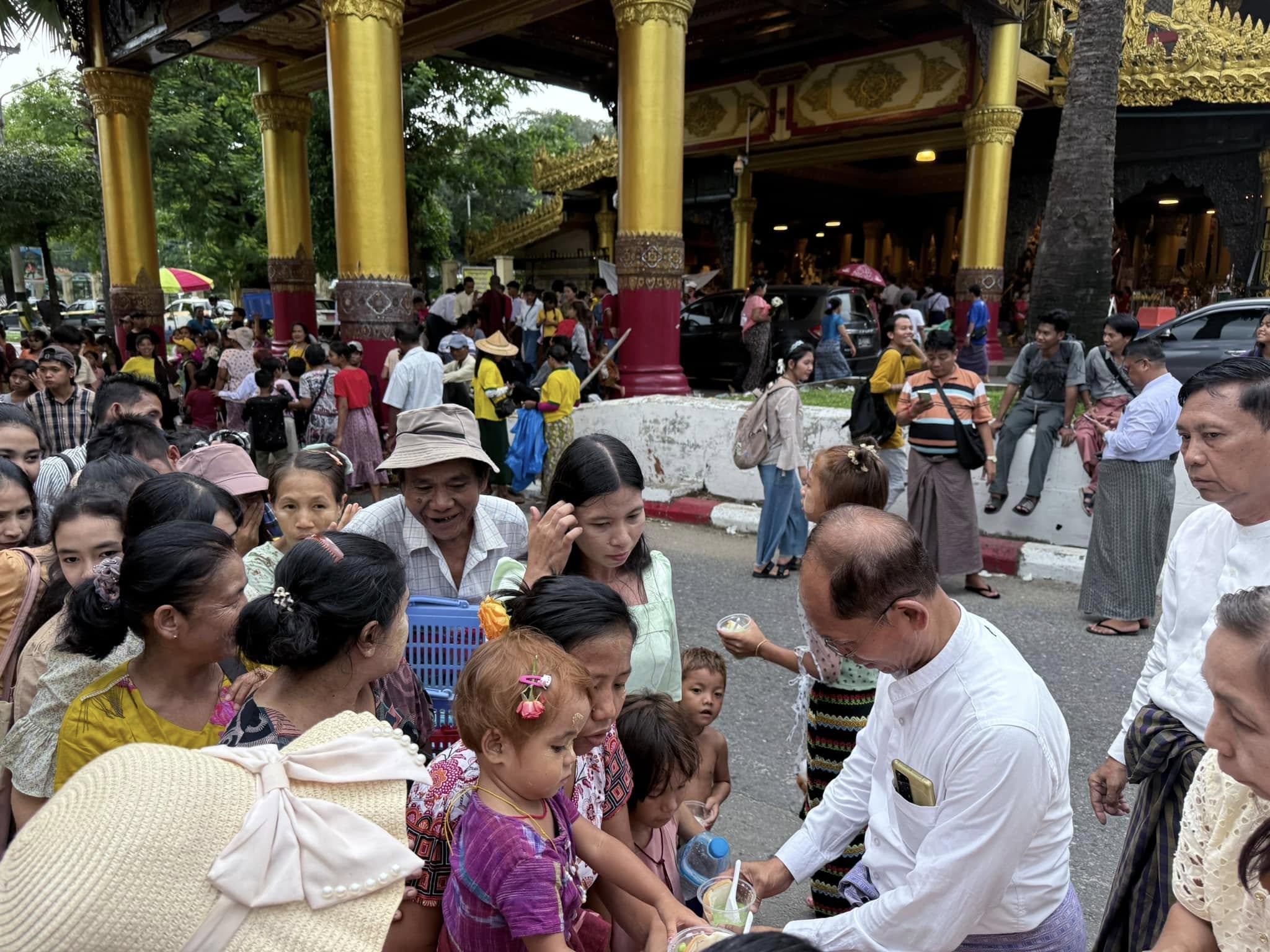
Giving Shwe Yin Aye ( cold sweet drinks) to the public
Political observers pointed out that because political parties fail to address the real hardships that people face, and only start making campaign speeches when they need votes during elections, the public has increasingly lost trust.
Similarly, giving out rice, oil, eggs, and other food items during election season to persuade people to vote is also not considered a firm policy or a principled stance, they added.
In response, U Hla Thein, spokesperson of the Union Solidarity and Development Party (USDP), told CNI News that political parties should not be prohibited from carrying out charitable acts while doing party work.
He said: “When rice or oil is given to the public, they give it out of their own goodwill. Should a political party be banned from doing charitable deeds while engaging in party activities? People also need to think about this. For example, if someone wants to offer alms to monks, should they not be allowed to? This isn’t political campaigning. It’s voluntary charity. Should charity for the people also be disallowed? People need to understand this. It’s difficult to speak to those who criticize everything—some people look at everything with suspicion,”.
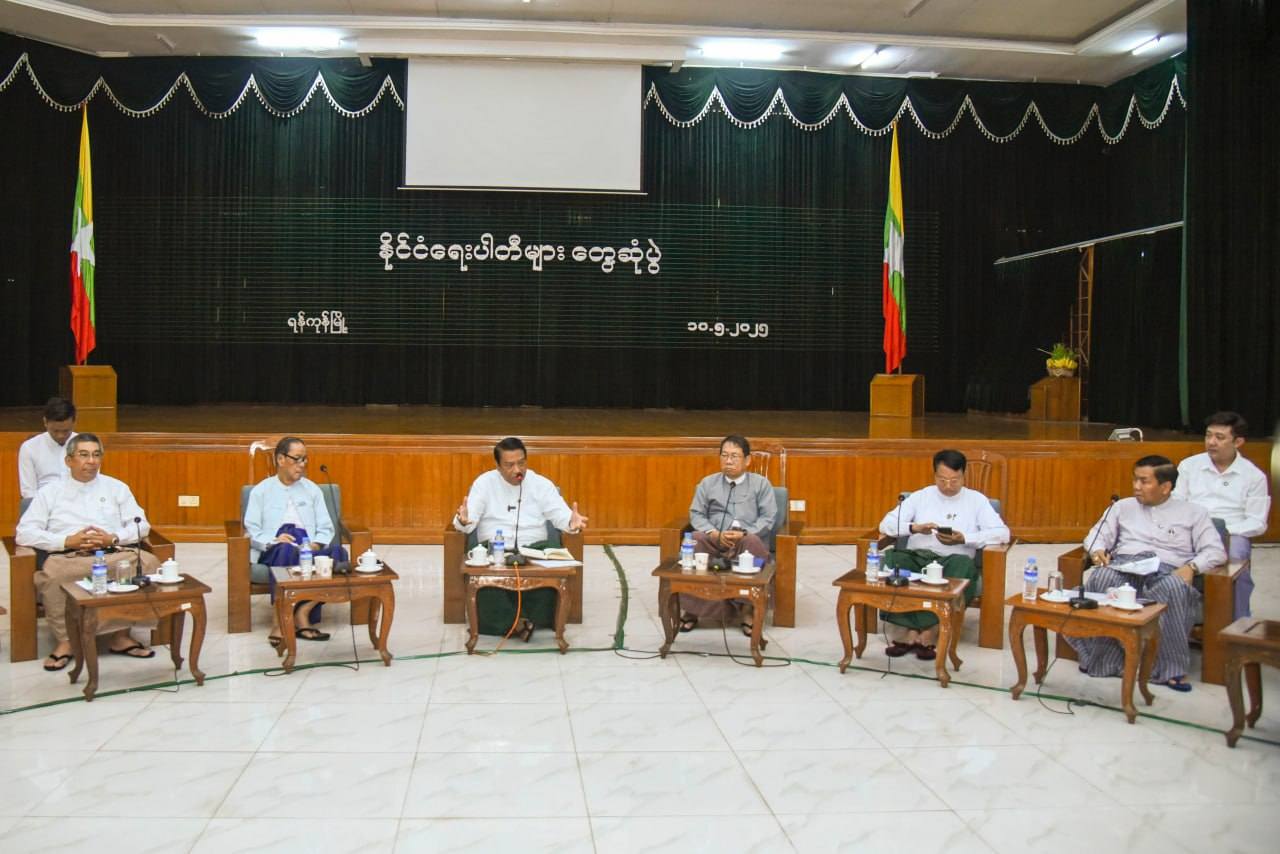
Political parties
Observers note that although giving basic food items to the public is good in itself, when such donations happen only during election periods and disappear afterward, it raises the question of whether the intent is sincere charity or self-serving political gain.
Additionally, political parties often fail to fulfill the promises made during their election campaigns, and many elected representatives do not even return to their constituencies after winning. Because of such failures, public trust in political parties has eroded.
Myanmar will hold Election Phase 1 on December 28, 2025. Phase 2 will take place on January 11, 2026, followed by Phase 3 in the last week of January 2026, according to an announcement by Major General Zaw Min Tun, spokesperson of the National Defense and Security Council, on November 10.

- By CNI
- Category: English Section
- Hits: 153
CNI News
26 November 2025
Due to significant improvements in governance and stability in Myanmar, the United States has announced the termination of the Temporary Protected Status (TPS) previously granted to Myanmar nationals. The announcement was made by the U.S. Department of Homeland Security on November 25, 2025.
The termination will take effect starting January 26, 2026.
According to the U.S. government, the decision was based on a review of Myanmar’s conditions conducted by the U.S. Citizenship and Immigration Services (USCIS), as well as consultations with the U.S. Department of State.
The U.S. government stated that Myanmar’s current situation has improved to the point where Myanmar citizens can safely return to their home country, which is why the temporary protection status has been withdrawn.
It was also noted that Myanmar has made remarkable progress in administrative stability, lifted its state of emergency, and is carrying out plans for free and fair elections.
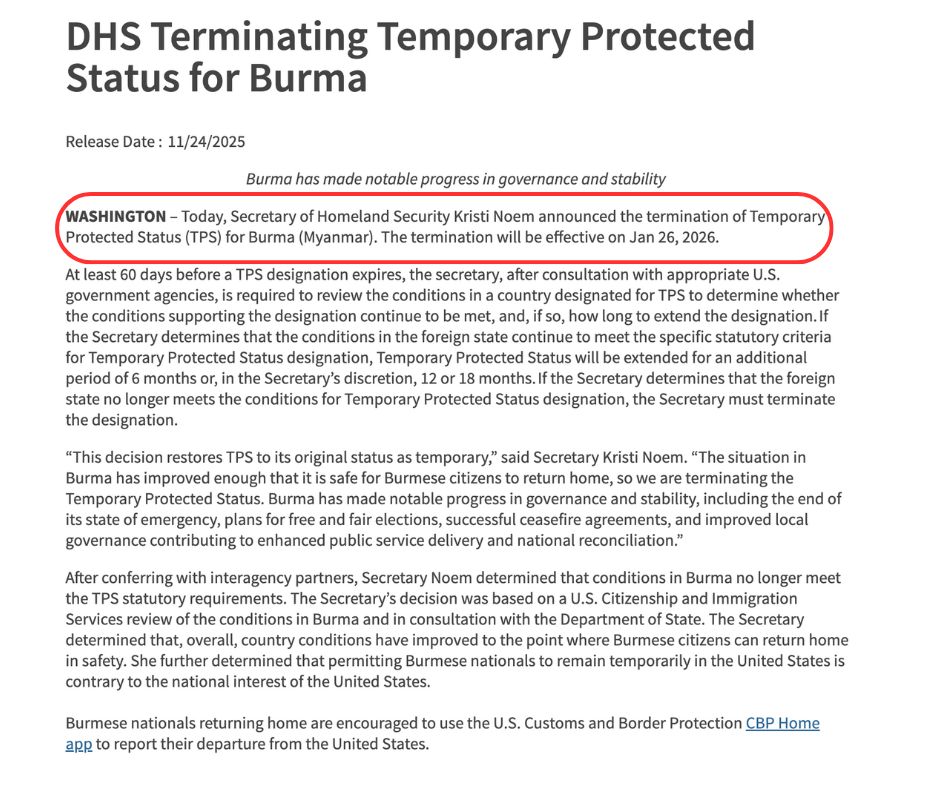
Announcement of TPS termination for Myanmar
Additionally, the U.S. government highlighted progress in public service delivery and national reconciliation due to successful ceasefire agreements and improved regional administration.
Because of these developments, the United States declared that Myanmar nationals can now safely return home.
Currently, Myanmar is set to hold elections in several phases: Phase 1: December 28, 2025 — in 102 townships. Phase 2: January 11, 2026 — in 100 townships. Phase 3: To be held in the last week of January 2026.
The upcoming elections in Myanmar are expected to bring political change, and the public is encouraged to vote for those who will protect the nation’s three main duties (Our Three Main National Causes) and help advance economic development, according to Chairman of the National Security and Peace Commission, Senior General Min Aung Hlaing.
He added that once the elections conclude, state power will be transferred to the winning party, and the military (Tatmadaw) will focus solely on national defense.

- By CNI
- Category: English Section
- Hits: 115
CNI News
25 November 2025
Questions are increasingly being raised among political observers about why the Myanmar public has lost trust in political parties.
Although there are many ways to resolve the current political crisis, political parties largely believe that the election is the least harmful way forward.
However, because the results of past elections were annulled on the grounds of voter list disputes, the public now has little confidence in the upcoming election and is not interested in it. Likewise, election observers note that the public also has little trust in the political parties who choose to participate in an election that the public does not support.
U Htet Aung Kyaw, a political analyst, told CNI News that a political party can only win public recognition when it truly represents the people and speaks up for their difficulties.
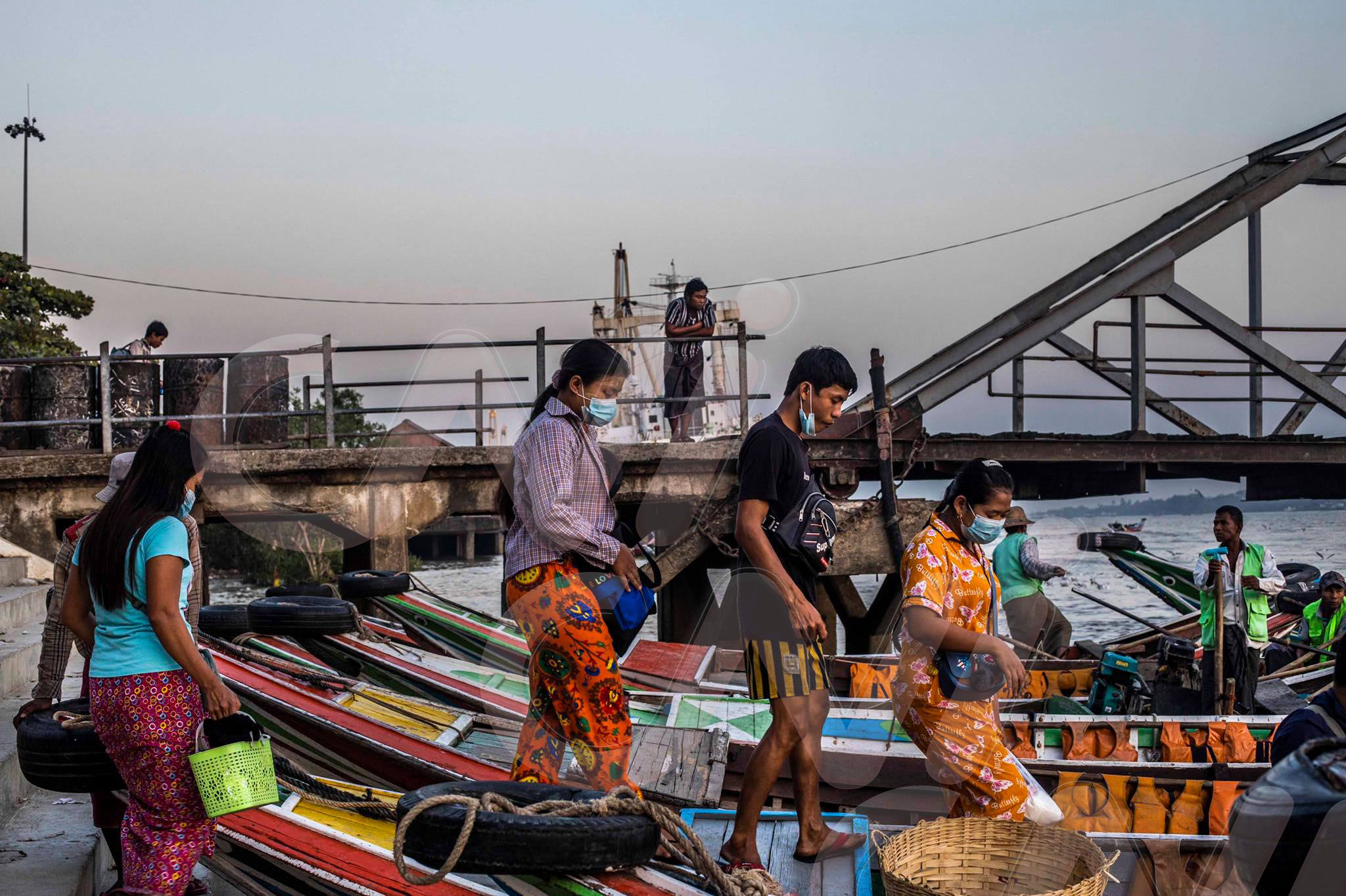
Grassroots communities seen
“It’s quite simple. When you establish a political party, it must represent the people.If it cannot represent the people, how can people like it? Only parties with many people who boldly speak out about public hardships will be recognized by the people as their true representatives—a party that genuinely stands on their side.Now, there are very few people who dare to speak this way.That’s why the public does not trust these parties.”, he said.
The public is struggling daily for food, basic needs, and job opportunities, and as a result, many no longer show interest in elections.
Additionally, the Spring Revolution forces have declared that they will disrupt and prevent the election, and that participants will face consequences. This has made the public stay even further away from the election process.
Daw Sandar Min, an independent candidate from Latha Township, told CNI News that the public has not lost trust but is instead afraid, due to the actions of political actors and activists since 2021.
“It’s not that they don’t trust; people are afraid.There is fear.After 2021, all the incidents that happened, the behaviors and actions of politicians and so-called revolutionaries, caused fear among the public.People have faced terrifying experiences that frightened them deeply.So I believe people are more scared than distrustful.There are good politicians and bad ones in every country.Some do politics with integrity, some exploit it.That’s why politics has gotten a bad name—because of those who exploit it.”, she said.

USDP campaigning
Currently, the public is dealing with a wide range of hardships: high commodity prices, inflation, lack of job opportunities, restrictions on overseas work, unlawful arrests under conscription laws, extortion, weak rule of law that leads to rising crime, and insecure domestic travel.
Additionally, because of ongoing conflicts, people are being displaced, agricultural work has become difficult due to high input prices, students have lost access to education, and healthcare costs have skyrocketed.
Political observers point out that political parties have lost public trust because instead of working to address these hardships, they only appear during the election period, asking for votes.
When the interests of the public clash with the interests of the party, political parties tend to protect their own party interests, leading the public to lose faith in political parties and trust individual candidates instead.

- By CNI
- Category: English Section
- Hits: 135
CNI News
25 November 2025
A political analyst told CNI News that if the majority of the public becomes interested in and votes in the upcoming multi-party democratic general election in Myanmar, it could pose a danger to the Union Solidarity and Development Party (USDP).
“Right now, many people are not very interested in the election. Those who are interested are mostly USDP supporters or military supporters. Only people who support USDP seem to be engaged and ready to vote. Many people are saying that this lack of public interest is actually good for the USDP. Why? Because if people stay uninterested, USDP will likely win. The votes that come in will mainly be theirs. But if the majority of the public becomes interested in the election and turns out in large numbers, that becomes dangerous for them. A high turnout would likely mean more votes against them. This is very different from times when the NLD was participating.”, he said.

USDP party
The first phase of the election will be held on December 28, 2025, four years after the political changes that occurred in 2021.
Phase (2) will take place on January 11, 2026, and two weeks later Phase (3) will follow, according to Maj-Gen Zaw Min Tun, spokesperson for the National Defense and Security Council, who announced this on November 10.
This year’s election will not be conducted solely under the First-Past-The-Post (FPTP) system, which was previously used in all elections since independence in 1947. Instead, two systems will be mixed: FPTP and Proportional Representation (PR).
Military and political analysts believe that this election—which will be held after more than four years of political crisis—could mark a turning point toward resolving Myanmar’s political problems.
However, a political analyst told CNI News that the election will not have a significant impact on the ongoing widespread armed conflicts.
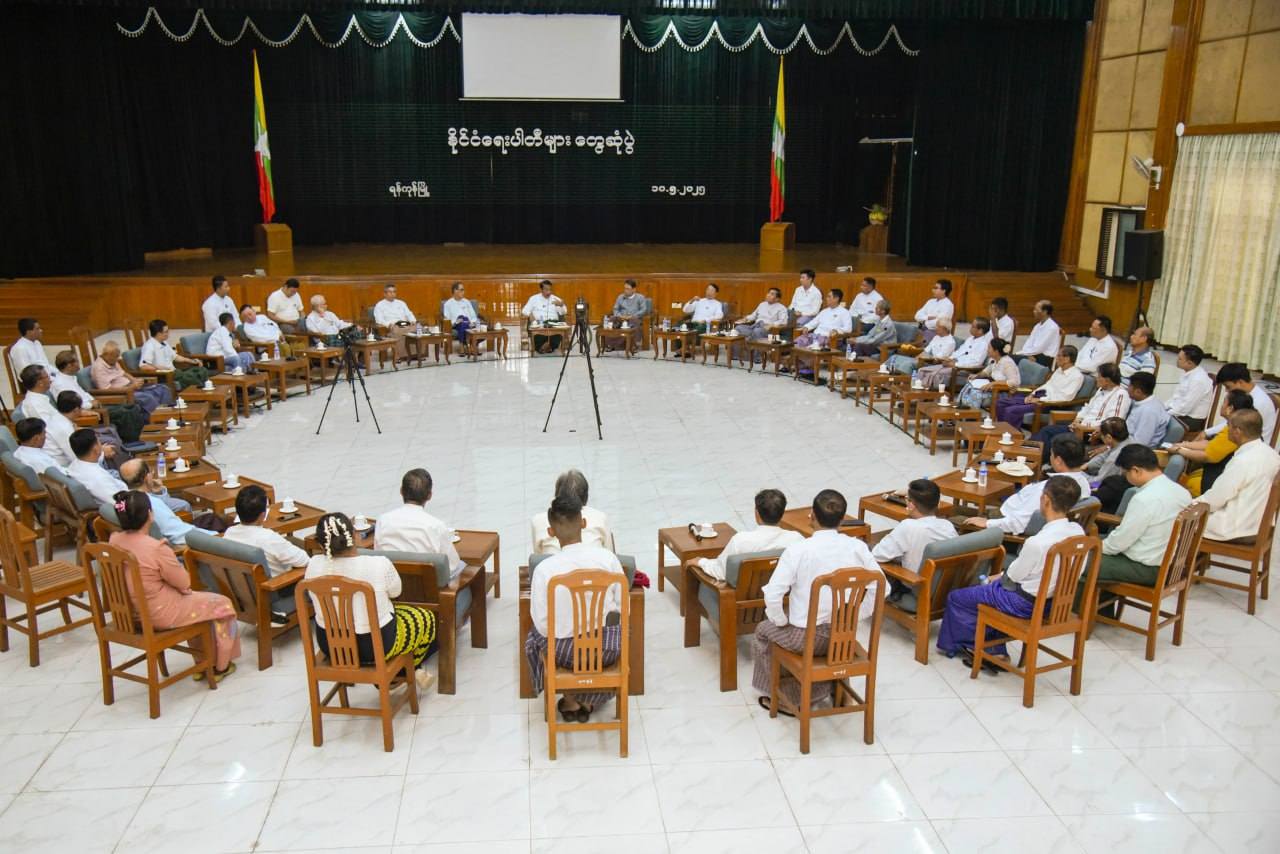
Political parties meeting
“I don’t think the election will have much effect on the armed conflicts. The main external influence on these conflicts comes from China. Because of China’s involvement, it could also lead to political disagreements and fragmentation in practical cooperation between the ‘Three Brotherhood Alliance’—TNLA, MNDAA, and AA—was able to seize large territories during Operation 1027 and NUG-PDF forces. But I don’t think the election itself will have a major impact on the armed conflicts.”, he said.
Of the total 5,023 parliamentary candidates in this election, 86 candidates have been disqualified for not meeting legal requirements.
The National League for Democracy (NLD), Shan Nationalities League for Democracy (SNLD), and Arakan National Party (ANP)—all of which hold strong public support—are not participating in this election.
As a result, the public shows little interest or enthusiasm in voting, putting USDP in a favorable position.

- By CNI
- Category: English Section
- Hits: 117
CNI News
25 November 2025
Senior General Min Aung Hlaing, Chairman of the State Security and Peace Commission, said that he wants voters to consider and cast their votes for those who can protect, preserve, and safeguard the Our Three National Causes.
He made these remarks on November 23, 2025, during a meeting with district- and township-level departmental officials, town elders, and community leaders in Maubin, Ayeyarwady Region.
Senior General Min Aung Hlaing stated that preparations are underway to ensure that the upcoming election will be free, fair, and just. He added that candidates are being screened according to the law and emphasized that people should vote for those who can work for the interests of the nation and regions; those who can protect, maintain, and safeguard the Three National Causes; and those who have political, economic, and defense perspectives.
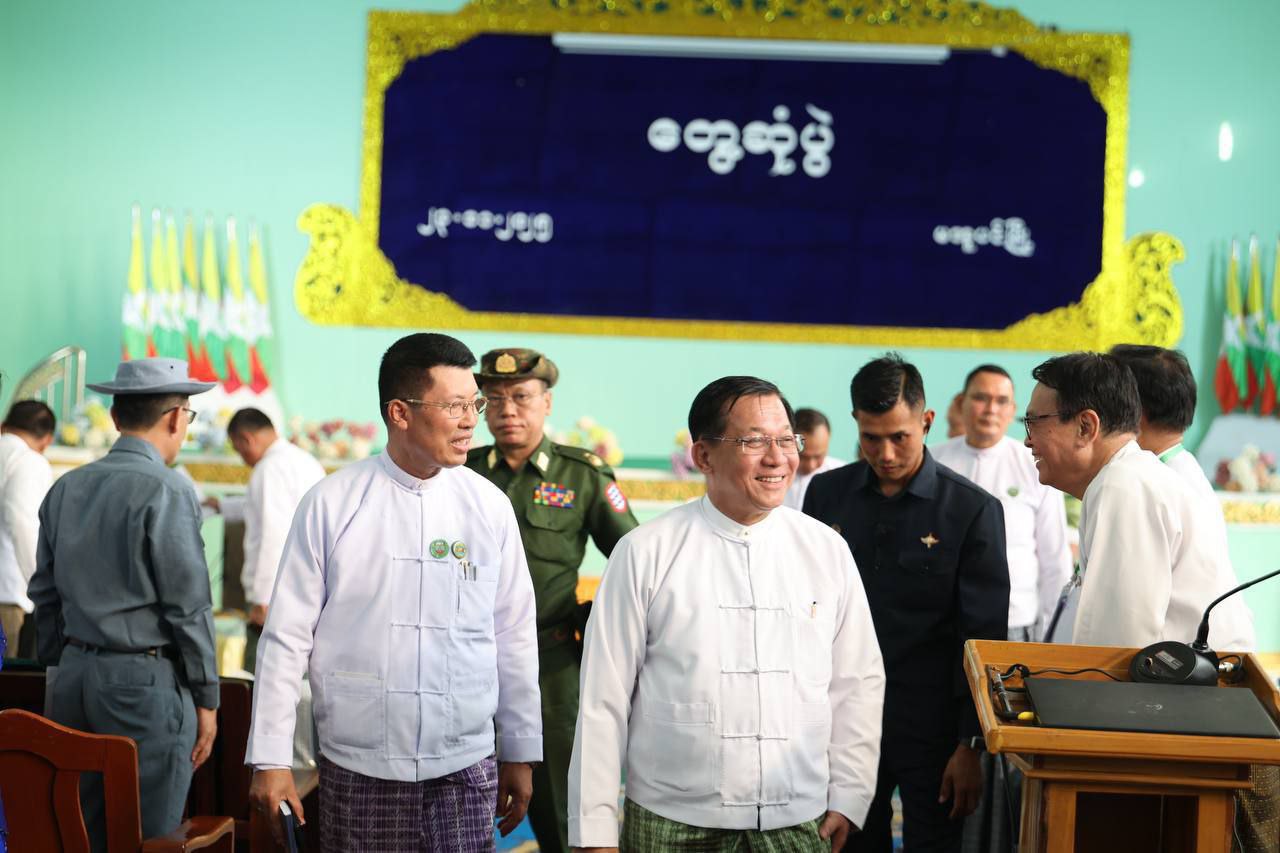
The first phase of the election will be held on December 28, 2025, in 102 townships. The second phase will be held on January 11, 2026, in 100 townships. The third phase will be held in the last week of January 2026.
He stated that arrangements have been made to ensure that eligible voters can cast their ballots, but whether they choose to vote or not is entirely their decision.
According to the 2008 Constitution, every citizen has the duty to protect and safeguard the Three National Causes.
These Three National Causes are:
Non-disintegration of the Union
Non-disintegration of national solidarity
Perpetuation of national sovereignty
Since Myanmar gained independence on January 4, 1948, armed conflicts have continued between the Myanmar military(Tatmadaw) and ethnic armed groups. After February 1, 2021, more intense armed conflicts have erupted, resulting in over three million internally displaced people.
As a result, ethnic unity has deteriorated, and Myanmar is approaching a state of Union disintegration, according to military and political analysts.

- By CNI
- Category: English Section
- Hits: 173
CNI Articel
24 November 2025
Myanmar’s election has been announced to take place in three stages: Part (1) on December 28, 2025; Part (2) on January 11, 2026; and Part (3) in the final week of January 2026.
This election is described by some as one that could bring a turning point for the country, while others believe no change will come out of it at all.
In any case, it is important to understand how the public views the election, how they perceive it, what they expect from it, and what their desires are.
When referring to the public, it may be useful to categorize them into three groups:
The group that supports the military and the USDP
The neutral or undecided public
The public that supports the resistance movement
Among these three groups, the first and third are quite straightforward.

USDP campaigning
The first group supports the election and believes that the new government after the election will be led by the military and the USDP.
The third group opposes the election, so they have no interest in the election period or the post-election period.
Therefore, the opinions of the second group—the neutral public—regarding the election period and the post-election period are particularly interesting.
The neutral public does not like the current national situation.
For that reason, even though they do not fully like the election, they do not reject it; they simply watch the situation carefully, hoping that it might bring some kind of change to the current state of the country.
During the election period, the neutral public hopes for political parties that can address the day-to-day hardships faced by ordinary people.
Most of the neutral public does not trust or expect the promises of political parties about restoring democracy, establishing a federal union, achieving peace, or stopping the fighting.

Political parties meeting
Their reasoning is that these are policies that would take at least ten years to achieve, even under ideal circumstances, and in Myanmar’s current situation, they believe such promises are simply deceptive attempts to win votes.
Therefore, most of the neutral public expects and hopes only for practical election promises—those that can realistically address the social and livelihood hardships currently faced by the public.
Most people are struggling with rising commodity prices, unlawful arrests under the conscription law and demands for payments, shortages of goods, increasing theft and robbery, fewer job opportunities, reduced income, inflation, lack of safety during travel and extortion, weak rule of law, and the government’s poor response to public complaints.
Likewise, they face difficulties such as the inability to easily obtain passports, excessive payments demanded for processing them, restrictions on leaving the country, extortion under various pretexts, barriers to working abroad, lack of full electricity supply, extremely high land and rental prices, and excessively expensive vehicle prices.
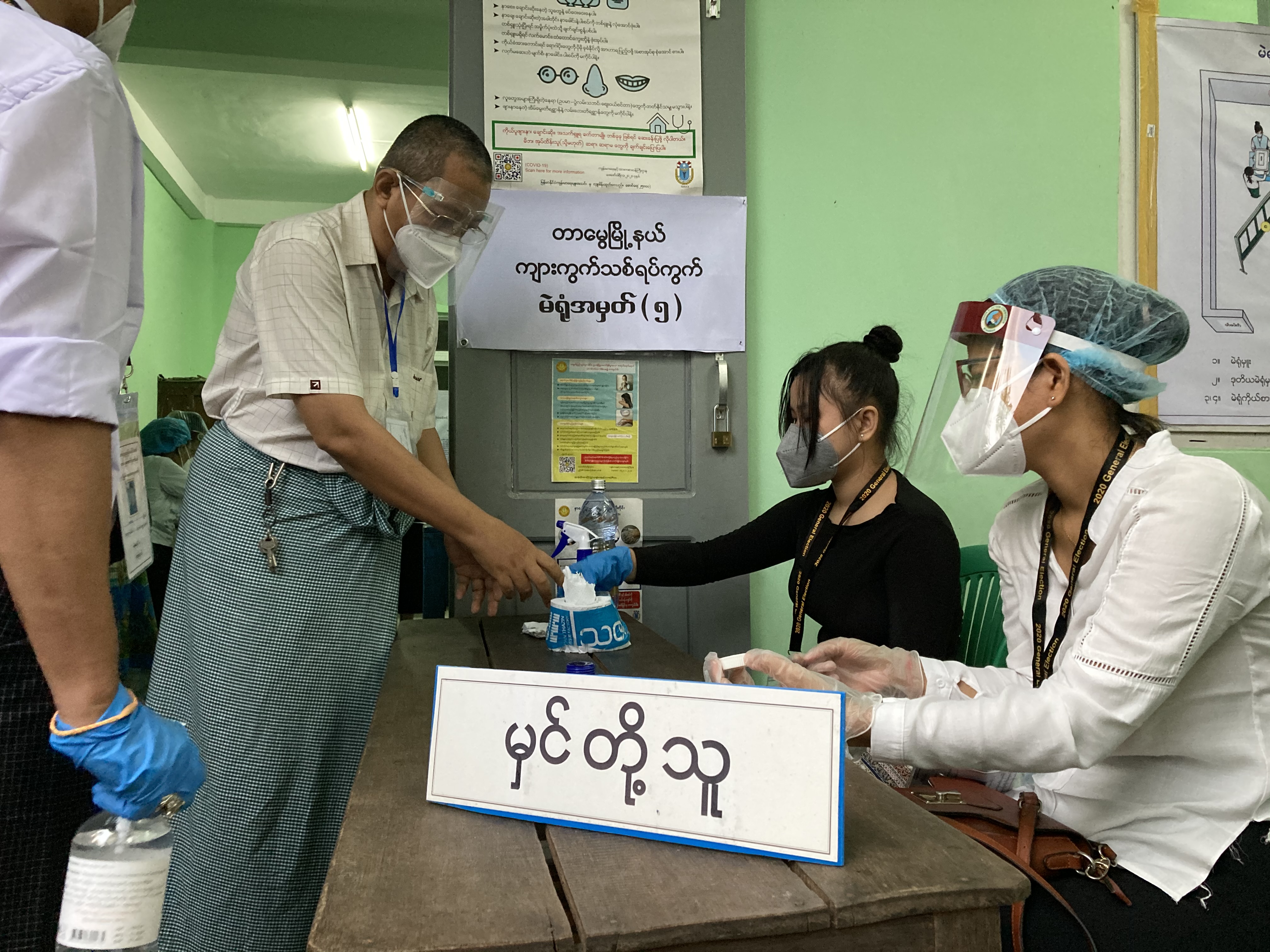
People waiting to cast votes
Therefore, the majority of the public is considering voting only for political parties that promise—and seem capable of—solving these immediate social and livelihood problems.
At present, no political party has been seen campaigning with a credible promise to solve these problems, nor is there a party that has convincingly given such guarantees.
Moreover, the neutral public is also watching the post-election period with great interest, analyzing it carefully. They are considering which party might form the government, what kind of government might emerge, what policies might be adopted, which party in power could bring hope, and which might leave things unchanged.
In any case, given the political crisis, armed conflicts, international economic sanctions, the decline in livelihoods, inflation, weak national security and rule of law, halted trade flows, and social fragmentation in Myanmar, the neutral public hopes for a new government that can genuinely resolve these issues.
Thus, most of the neutral public hopes that the post-election government will be formed as a national unity government based on national reconciliation.
Their belief is that Myanmar’s numerous crises can only be overcome if all citizens unite and work together.
Therefore, it remains to be seen how the expectations of the three public groups will evolve during the election period and the post-election period.

- By CNI
- Category: English Section
- Hits: 182
CNI News
22 November 2025
If Myanmar is to move toward a federal system, it must be built only after ensuring fair give-and-take, compromise, and mutual concessions among all sides, said political analyst U Htet Aung Kyaw.
Senior General Min Aung Hlaing, Chairman of the State Security and Peace Commission, recently stated that in implementing democracy and federalism, Myanmar would adopt a territory-based federal system, not an ethnicity-based federal system, and that it would fit Myanmar’s own context.
It is believed that the preference for a territory-based federal model is due to concerns that states organized based on ethnicity have historically led to division and dissatisfaction.
Political analyst U Htet Aung Kyaw told CNI News that if Myanmar is to adopt a federal system, it must be done through thorough negotiations ensuring that all sides agree on the terms.
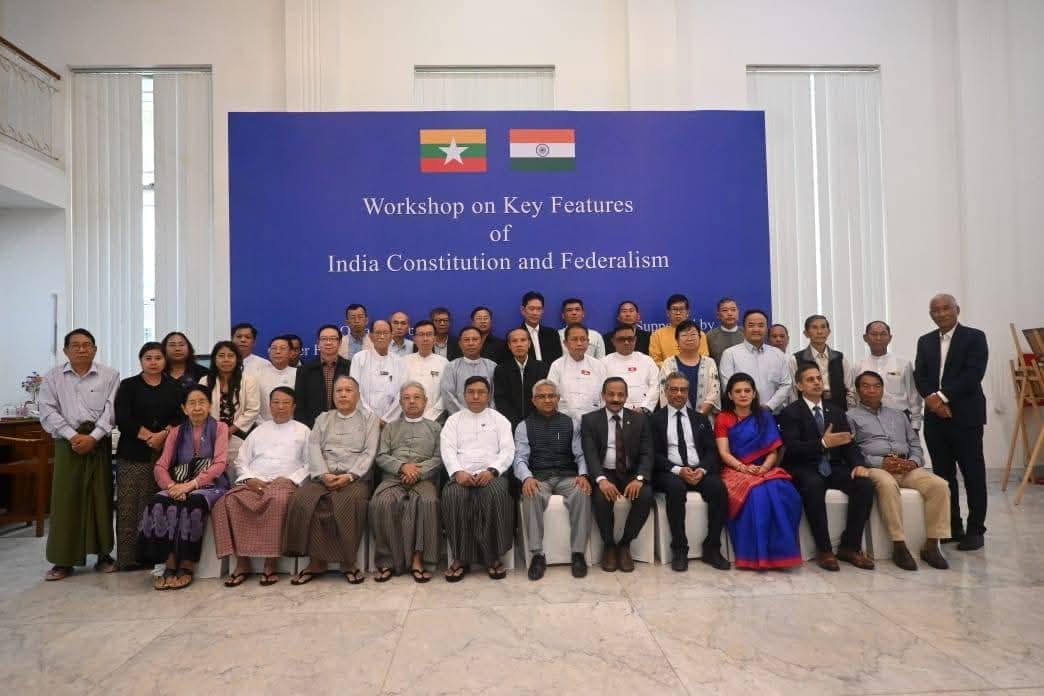
Participants seen attending a federalism workshop hosted by the Embassy of India.
“Given the current political situation, everyone now believes that a federal system is the only way forward. Even the military agrees that the country must adopt this system. But the question is: What form should it take? Sometimes one side thinks a particular model is good, but the other side cannot accept it — which can make the situation worse. That is why, in moving toward a federal system, it is better not to rush. We need repeated and thorough discussions until we reach a situation where everyone is satisfied. Only then should we implement the system. That is why give-and-take, compromise, and mutual concessions must be carefully worked out before proceeding.”, he said.
Although all sides in Myanmar agree in principle on establishing a federal union, what exact form of federalism will be implemented has not been clearly presented.
The Myanmar military (Tatmadaw) has proposed adopting India’s federal model, while ethnic armed organizations have expressed preference for federal systems practiced in the United States, Canada, Switzerland, and Germany.

Participants seen attending a federalism workshop hosted by the Embassy of India.
USDP spokesperson U Thein Tun Oo told CNI News that federalism is fundamentally related to territorial administration, not ethnicity.
“Federalism is based on territory. When we talk about making laws and administering governance, it naturally corresponds with geographical areas. If it is based on ethnicity, then policies would be shaped according to the mindset of those specific groups — which may or may not be practical. What I want to say is that it is more appropriate to design a federal system based on the specific conditions of each region.”, he said.
The Nationwide Ceasefire Agreement (NCA), signed by the Myanmar military, the government, parliament (Hluttaw), and ethnic armed groups, states that Myanmar will build a Federal Democratic Union based on outcomes from political dialogue.
However, to this day, no concrete agreement has been reached regarding the exact type of federal system or the details of democratic reforms.

- By CNI
- Category: English Section
- Hits: 195
CNI News
22 November 2025
The upcoming election will be a turning point for the nation, according to Senior General Min Aung Hlaing, Chairman of the State Security and Peace Commission.
He made the remarks during the 2024 National Lifetime Literary Award, National Literary Award, and Sarpay Beikman Manuscript Award Ceremony held on November 20, 2025.
Senior General Min Aung Hlaing said: “While the government is striving to ensure political stability and to successfully organize elections in an orderly manner, the public, too, must take part in this election — a turning point for the country — as a national duty. Citizens should maintain unity, patience, and work together toward a better future.”
He stated that the elections would be held phase by phase, and townships unable to participate for various reasons would have elections conducted later when possible. As the election period approaches, maintaining national peace and stability becomes increasingly important, he added.
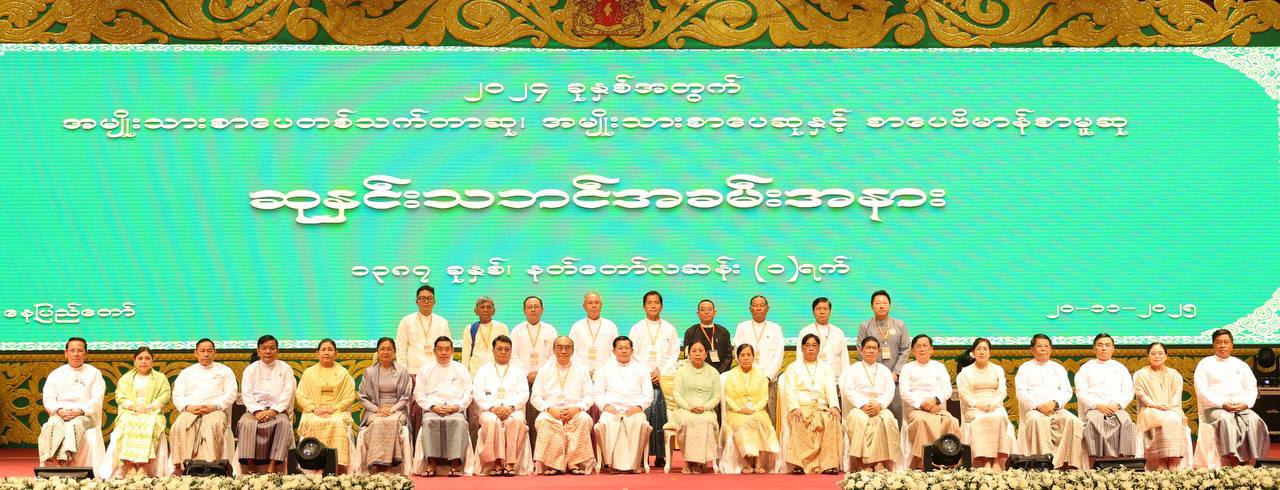
Senior General Min Aung Hlaing further said: “By prioritizing national interests and implementing a genuine, disciplined multi-party democratic system, the collective development of the Union, domestic peace, and the sustained socio-economic advancement of the people can be achieved. Public participation is crucial for the success of general elections under a multi-party democratic system. Our people must cultivate good democratic habits, acquire knowledge, and develop modern awareness through literature and education.”
In Myanmar, Phase 1 of the election will be held on December 28, 2025, in 102 townships. Phase 2 will be conducted on January 11, 2026, in 100 townships, followed by Phase 3 in the last week of January 2026.
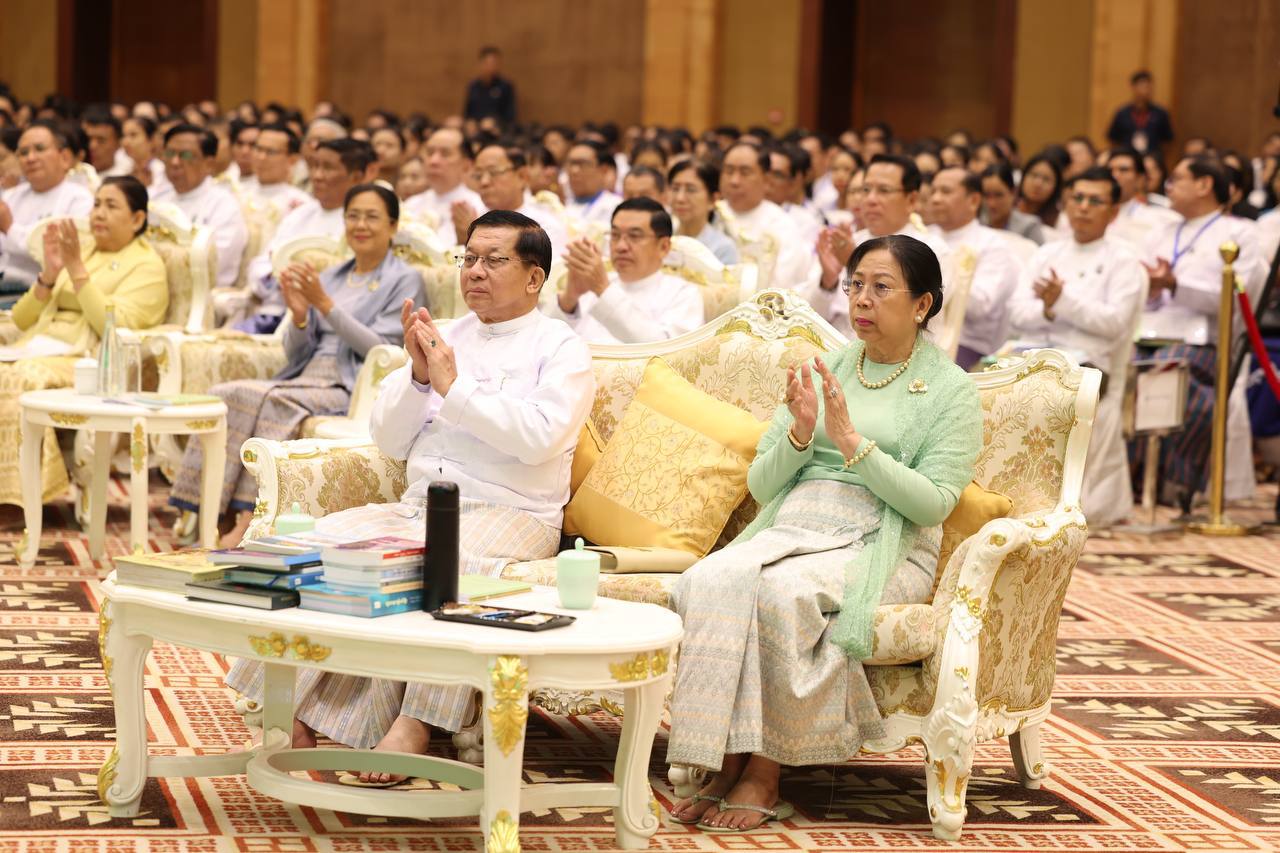
Political observers note that in the current electoral landscape, the Union Solidarity and Development Party (USDP) faces no strong competitors, giving the party a significant advantage in forming the next government if it wins the election.
Therefore, they argue that if the next government continues with the current structure and policies, major changes in the country are unlikely.
Analysts further point out that to create meaningful change — including resolving the ongoing political crisis, armed conflicts, and international economic sanctions, as well as improving socio-economic conditions — the post-election government must consider forming a Government of National Unity.



